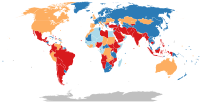
Photo from wikipedia
Introduction Since the coronavirus disease outbreak in 2019, there have been several preventive measures and restrictions applied to minimize the transmission of the virus. While lockdown has affected our everyday… Click to show full abstract
Introduction Since the coronavirus disease outbreak in 2019, there have been several preventive measures and restrictions applied to minimize the transmission of the virus. While lockdown has affected our everyday lives, it has negatively impacted sport and athletes as well. Methods 1,387 Slovenian dual-career (DC) athletes (47.4% females, 52.6% males) participated in the 22-item questionnaire to gather information on their sports and academic engagement before and during COVID-19 lockdown period. Half of the athletes were enrolled in education at the secondary level (n = 819, aged 15–18 years), while the others were enrolled in primary (n = 301, 8–14 years) and tertiary (n = 267, 19–36 years) education. All participants in the current study have a valid athlete categorization by the Slovenian Olympic Committee and are competing at either junior (31.7%), national (26.9%), prospective (29.5%), international (8.5%), world (2.3%) or Olympic (1.2%) level. Results DC athletes spent less time on training (−4.7 h; p < 0.001), learning (−1.0 h; p < 0.001), exams (−0.9 h; p < 0.001), laboratory work (−0.6 h; p < 0.001), and other educational activities (−0.3 h; p < 0.001) during COVID-19 lockdown compared to period before the lockdown. Their training environment was changed so they trained either at home or outdoors. Results showed that indoor (−3.7 h; p < 0.001) and team sport athletes (−1.3 h; p < 0.001) trained less than outdoor and individual sports. Male athletes spent more time on training both before (1.3 h; p < 0.001) and during lockdown (1.3 h; p < 0.001) and other sport-related activities (1.3 h; p < 0.001). On the other hand, female athletes spent more time on studying both before (1.5 h; p < 0.001) and during lockdown (2.6 h; p < 0.001). Both sport and educational activities were influenced by athletes’ age (p ≤ 0.017). Conclusion Indoor and team sport athletes were more affected by the governmental measures than outdoor and individual sport athletes. Male athletes experienced a greater decline in learning time compared to female athletes. DC is shown to be beneficial for athletes even in times of COVID-19 lockdown, as DC athletes report smaller decline in motivation, shifting attention from sport to study and having fewer mental problems due to uncertain sports future. The feedback of the preventive measures could serve to assist policy makers and athlete’s support staff to form and apply preventive measures that are more effective for DC athletes’ training and education.
Journal Title: Frontiers in Psychology
Year Published: 2023
Link to full text (if available)
Share on Social Media: Sign Up to like & get
recommendations!